Installation of autonomous heating in the apartment: choose
Do you own an apartment in a house with centralized heating, and you are not satisfied with the prospect of supplying heat from the beginning of the season approved by the house management? In this case, you will certainly be interested in the instructions for the implementation of autonomous heating systems of enclosed spaces.
Before considering the specific schemes of the current heating systems, we will determine the advantages and disadvantages of them.
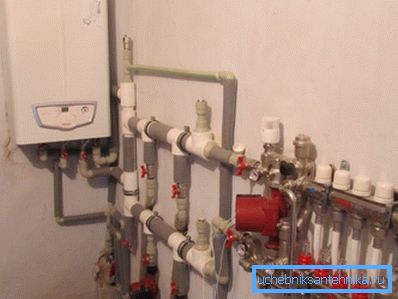
Among the characteristic advantages, we note the following points:
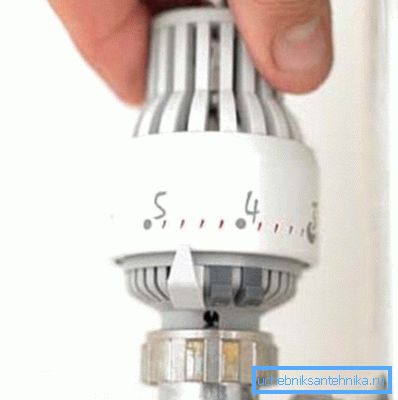
- The ability to adjust the temperature of the coolant in accordance with their preferences and based on the climatic conditions characteristic of a particular season. That is, it is not necessary to start flushing only with the onset of severe colds, because you can periodically warm up the room in the offseason and thus achieve the required comfort.
- The possibility of economical consumption of energy and, as a consequence, the possibility of reducing the costs associated with heating.
Despite the fact that the price of heating in apartment buildings is high, heat is consumed inefficiently. For example, the central system with the onset of warming can not be temporarily disabled. Therefore, we are forced to open the vents and release precious gigacalories to the external environment.
The autonomous system, in contrast to the centralized one, allows energy resources to be consumed when it is necessary and not otherwise. As a result, the cost of heating without sacrificing comfort will be reduced by approximately one and a half times.
- Possibility of automation of heating equipment and interfacing with the “Warm Home” system.

As a result, the equipment, through a thermostat, itself monitors temperature changes and compensates for possible differences.
This is a significant advantage if the apartment is used for seasonal living. Automation allows you to maintain optimal temperature parameters, then when you are not home for a long time. Professionally implemented automation of autonomous heating allows you to set the comfort conditions of the microclimate at a distance by means of mobile communication.
Are there any disadvantages?
Unfortunately, there is:
- First, some categories of heating equipment are subject to licensing without fail.
- Secondly, the sales price of autonomous heating systems of enclosed spaces, regardless of the type of equipment purchased, is high. These costs should be added labor costs and the time it will take to implement the project.
Choosing the basis of autonomous heating - boiler
How to start independent heating of the apartment? Of course, with the choice of the heat source. After all, the type of other utilities depends on how this device will be.
The choice of heat source is carried out in accordance with the following criteria:
- available fuel type;
- area of heated premises;
- budget allocated to the project;
- availability of special premises suitable for placement of equipment.
At the moment, the market has a large selection of heating equipment, which, in accordance with the type of fuel used, can be divided into the following modifications:
- solid fuel;
- liquid fuel;
- gas;
- electric.
For obvious reasons, solid and liquid fuel modifications for use in the apartment are not suitable.
Therefore, it is necessary to focus on electric and gas boilers.
- Natural gas boilers can be used in homes with a height of no more than 9 floors. According to the regulations, houses above 9 floors are not gasified.
Gas boilers heating method of installation can be floor and wall. Given the limited space in most traditional apartments, the choice of wall equipment is preferable, which can be equally well placed in the kitchen, balcony or loggia.
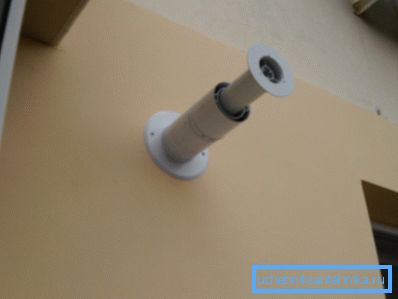
Gas fired boilers may be volatile and non-volatile. Most modern plants depend on the availability of electricity, as they provide for automatic ignition of the flame, forced circulation of coolant and forced discharge of exhaust gases.
Equipment independent of the power supply, as a rule, is represented by domestic products with a floor layout. Such boilers not only occupy a lot of space, but also do not suggest the possibility of automating the heating process, and therefore it is advisable to refuse their choice.
- Electric heating boilers are suitable for installation and operation in non-gasified houses.. Along with the traditional domestic developments, today you can purchase Western European electric boilers, the operation of which is not only efficient, but also economical.
Important: The electric boiler for heating is simple and convenient in terms of daily use. But most importantly, such equipment does not require mandatory licensing as gas installations.
After we have decided on the optimal parameters of the boilers, we will consider which scheme of independent heating of the apartment is preferable.
Actual schemes
Installation of heating autonomous heating in the apartment can be implemented using various methods.
But if we mean the water circuit, then you can use the following schemes:
- single pipe;
- two-pipe;
- "Warm floor".
Consider each of these systems in more detail:
- Systems "warm floor" as the main heating may apply in regions with warm climates. On the territory of the Russian Federation, this solution is used as a minor (auxiliary) and is used before the onset of cold today or for heating tile floors.

The essence of the technology lies in the fact that pipes, through which coolant circulates, are immersed in the floor screed. The pipes gradually release heat into the screed, warming it up.
Important: The system is not recommended for laying in the screed, on which laminate will be lined later, as frequent temperature differences can contribute to the deformation of the floor covering.
- The one-pipe heating scheme is a traditional scheme used in the simplest autonomous systems. Heating radiators in this case are installed in series, that is, one after the other.
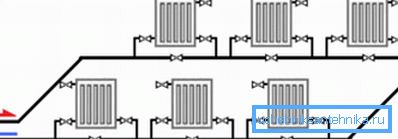
The principle of the system is as follows: the hot coolant from the boiler enters the pipe, and through it into the first radiator, then again into the pipe, then into the next radiator, etc. As a result, after passing through the entire system, the water comes to the boiler again cold in order to heat up again and go through a full cycle again.
A significant disadvantage of this principle of operation is that the temperature of the coolant in the first and last battery will be different. That is why the one-pipe scheme is suitable for use in small apartments where no more than 3-4 radiators are operated.
- The two-pipe heating system is completely devoid of the drawbacks characteristic of heating, implemented according to a one-pipe scheme. In this case, the coolant passes through a single supply pipe and from it through the branches enters the radiators. Already cooled water enters the boiler through a single return pipe.

A significant disadvantage of such systems is the high price, as the pipes need twice as much as in the previous version. In addition, all these pipes must somehow be placed.
There are the following placement methods: at the bottom of the battery, at the top of the battery, at the top and bottom of the battery, in a layer of plaster or in a screed.
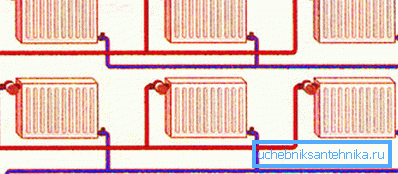
Choose one or another method of location of the pipes should be based on the height of the line of the window sill and in accordance with the peculiarities of interior design.
Choosing heating radiators
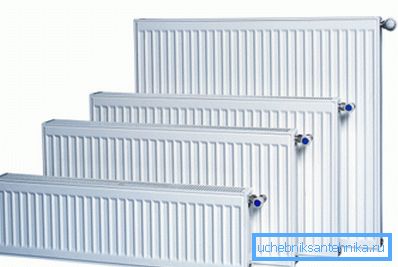
Before you make an autonomous heating in the apartment, you need to choose the type of batteries that will provide optimal heat transfer, fit into the interior design and will correspond to the budget set aside for the project.
Of the most popular to date radiators, we note the following modifications:
- aluminum;
- bimetallic;
- cast iron.
Immediately, we note that each of these modifications has its own advantages and disadvantages, which should be considered when choosing. But the most promising in terms of use in autonomous heating systems are bimetallic batteries.
Such devices have an attractive price, effectively release heat for a long time, do not provoke corrosive processes, look good and are guaranteed to fit into most modern interiors.
Pig-iron radiators, despite many obvious advantages, heat up for a long time. Aluminum counterparts, on the other hand, quickly heat up, but also quickly cool down.
Choice of pipes and related fittings
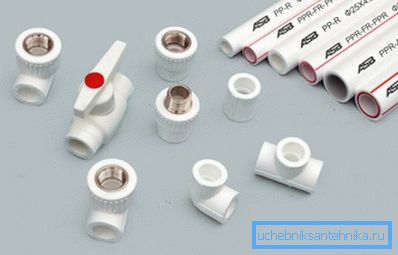
In order to make independent heating in the apartment with your own hands, besides the boiler and radiators you will need to purchase pipes and associated fittings. The circulation intensity of the coolant largely depends on the correctness of the choice of pipes. Moreover, for certain methods of installation of systems, some types of pipeline are suitable and other methods are not suitable at all.
Currently, among the assortment of pipes on the market, the following modifications are most popular:
- Metal pipes with collet connection applied over the past 15 years. They are a multilayer material consisting of a polymer base and thin metal reinforcement.
Due to the inner polymer layer such pipes are characterized by increased corrosion resistance. The only drawback of such a pipeline is the use of prefabricated fittings.
Crimp connection or fitting with the use of a nut can not be hidden in the screed or plaster, as over time the tightness may decrease, which is likely to lead to leaks.
- Polypropylene pipes, reinforced with aluminum or fiberglass, this is a more durable and durable solution, as the fittings are soldered. Polypropylene pipes (if properly installed) can be hidden in plaster or screed without fear of leaks.
Conclusion
So, we considered how according to what schemes the installation of autonomous heating is carried out in the apartment. You may be able to find any information relevant to your project.
Moreover, you will find a lot of interesting things by watching the video in this article.